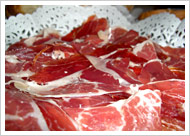
Introduction to Spanish Tapas
Home Practical information Introduction to Spanish tapas
The Spanish custom to eat tapas is a great way to enjoy Spanish fare because it allows you to try lots of different typical dishes at once.
 The origin of the Tapa is a little unclear but seems to have come from an old custom of covering a glass of wine with a piece of bread or a flat card to protect it from insects. This may have evolved to include a slice of chacina (dried pork) or jamón (ham). Another speculation is that the owners of taverns in Castilla-La Mancha, around the 16th century, discovered that they could disguise the smell of cheap or bad wine by covering it with a slice of cheese and thus began to "cover" the wine when it was served.
The origin of the Tapa is a little unclear but seems to have come from an old custom of covering a glass of wine with a piece of bread or a flat card to protect it from insects. This may have evolved to include a slice of chacina (dried pork) or jamón (ham). Another speculation is that the owners of taverns in Castilla-La Mancha, around the 16th century, discovered that they could disguise the smell of cheap or bad wine by covering it with a slice of cheese and thus began to "cover" the wine when it was served.
Madrid's tapas bar hopping scene has garnered a reputation worldwide for being "a must" when visiting, or living in, Spain. Spending a weeknight, or weekend afternoon munching these tasty mouthfuls is an unbeatable way to absorb a little more Spanish culture.
Tapas are typically served with small bits of bread, and in Madrid, they represent the best imported foods from the distinct regions of Spain.
 Each region has its own typical tapas. In the peninsular center they include queso manchengo (a cheese that is produced in the La Mancha region of Spain), in the north, tapas with la morcilla (blood sausage) are famous. In Cataluña bread with jamón serrano (cured ham) is the norm. Tapas with jamón (ham) or gambas (shrimp) are common in the region of Andalucia and frequently include aceitunas (olives). The price of tapas can vary anywhere from 50 centimos to 4 euros depending on the tapa. Prices can even vary for the same tapa depending on the quality of jamón (ham) you order.
Each region has its own typical tapas. In the peninsular center they include queso manchengo (a cheese that is produced in the La Mancha region of Spain), in the north, tapas with la morcilla (blood sausage) are famous. In Cataluña bread with jamón serrano (cured ham) is the norm. Tapas with jamón (ham) or gambas (shrimp) are common in the region of Andalucia and frequently include aceitunas (olives). The price of tapas can vary anywhere from 50 centimos to 4 euros depending on the tapa. Prices can even vary for the same tapa depending on the quality of jamón (ham) you order.
In Madrid the culinary offerings are varied and you can find the best from through out the country in its restaurants.
For example, seafood restaurants get their seafood directly from Galicia and the tuna from the north. The restaurants that offer roasted meats demonstrate the finest techniques from the peninsular north. In Madrid you can find the cochinillo (piglet) of Segovia, el botillo (pig intestine) de Ponferrada (León), paella (dish with saffron rice, vegetables or meat) from Valencia, aceite de oliva (olive oil) from Jaén or boquerones (anchovies) from Málaga. You cannot overlook the products of Extremadura, chorizo (highly seasoned pork sausage), jamón serrano (cured ham), lomo (pork loin), All of these are just a small sample of the enormous culinary offering of Madrid.
Here are some well-known tapas bars listed by area within the city:
Alonso Martínez - Bilbao
- Chipén
- Cardenal Cisneros 38
- Tel. 914 454 385
- Canister
- Gral. Álvarez de Castro 24
- Tel. 914 469 302
Chamartín-Prosperidad
- La Taberna del Sumiller
- Víctor de la Serna 37
- Tel. 913 598 595
Chueca-Malasaña
- Bocaíto
- Libertad 4
- Tel. 915 215 331
- El Pepinillo de Barquillo
- Barquillo 42
- Tel. 913 102 546
Cuatro Caminos
- Combarro
- Reina Mercedes 12
- Tel. 915 547 784
- La Consentida
- Hernani 53
- Tel. 915 336 216
- La Garriga
- Plaza Castellana 153
- Tel. 915 700 139
- El Quinto Vino
- Hernani 48
- Tel. 915 536 600
Huertas
- Cervecería Alemana
- Plaza Santa Ana 6
- Tel. 914 297 033
- La Dolores
- Pl. Jesús 4
- Tel. 914 292 243
- La Trucha
- Calle de Manuel Fernández y González 3
- Tel. 915 320 882
- La Venencia
- Echegaray 7
- Tel. 914 297 313
La Latina
- El Bonano
- Pl. Humilladero 4
- Tel. 913 666 886
- Delic
- Ctlla. San Andrés 14
- Tel. 913 645 450
- El Almendro;
- Almendro 13
- Tel. 913 654 252
- Tempranillo
- Cava Baja 38
- Tel. 913 641 532
- El Viajero
- Plaza Cebada 11
- Tel. 913 669 064
- Taberna Matritum
- Cava Alta 17
- Tel. 913 658 237
Lavapiés
- Melos
- Ave María 44
- Tel. 91 527 50 54
- La Taberna de A. Sánchez
- Mesón de Paredes 13
- Tel. 915 397 826
Malasaña - Conde Duque
- Bodegas El Maño
- Palma (Centro) 64
- Tel. 915 215 057
- El Pez Gordo
- Pez 16
- Tel. 915 223 208
- El Cangrejero
- Amaniel 25
- Tel. 915 483 935
- Bodegas La Ardosa
- Colón 13
- Tel. 914 151 346
- La Huida
- Colón 11
- Tel. 915 229 107
- Mesón Andino
- Ruiz 16
- Tel. 914 459 397
- Albur
- Manuela Malasaña 15
- Tel. 915 942 733